FRIEZE: Chris Kraus on Borders, Racism and Staying Put
Chris Kraus on Borders, Racism and Staying Put
A roundtable with Mexicali and Tijuana artists Mely Barragán, Pablo Castañeda, Fernando Méndez Corona and collector Alonso Elias. With a poem by artist Guillermo Gómez-Peña

I discovered the work of Pablo Castañeda and Fernando Méndez Corona in 2010, when I visited the border-adjacent gallery Mexicali Rose for the first time. Founded in 2007 in Mexico by filmmaker and critic Marco Vera, when he returned from Los Angeles to his old neighbourhood of Pueblo Nuevo, Mexicali Rose was, in fact, more than a gallery: it was an entire cultural centre, hosting media and trade workshops, film screenings, political meetings and a pirate radio station, before it closed in 2015.
At a time when the word ‘community’ had become a part of international art-world rhetoric, I was struck by the authenticity of the community that gathered around Mexicali Rose. I was also struck by the inventiveness, beauty and confidence of the work, and the fact that it was made by artists who were largely self-taught and not necessarily born into the privileged backgrounds that inform most contemporary art. In short, I was hooked.
Eventually, during numerous trips, I visited Mely Barragán and Daniel Ruanova’s wonderful China Project Space, the first in a cluster of artist-run galleries that repopulated Tijuana’s central downtown after it had been decimated by the escalation of violence in 2008. I met Alonso Elias, a hay merchant who began attending art openings for the free wine as an agronomy student and has become the most important collector of North Baja art. Built with his wife, Patty Fontes, the Elias-Fontes Collection reflects a local aesthetic that combines the themes and values of street art, muralism, international contemporary art and California/Baja California décor. The five of us met up at Aurelio’s Cocina Local in Mexicali this summer to talk about the situation of their generation of artists in Mexicali and Tijuana and what it’s like to stay in a small city rather than leave.
– Chris Kraus

Mely Barragán, Grabs Back, 2017, acrylic on tapestry cloth, thread, hairy texture, sequins on stretcher, 1.6 × 1.9 m. Courtesy: the artist; photograph: Pablo Mason
Chris Kraus Fernando, Mely and Pablo, you all began your careers in the 1990s, when there were fewer opportunities for artistic exchanges beyond Baja California than there are now. Did you feel, starting out, that you were up against considerable isolation? Did you think about moving to Berlin or Mexico City?
Mely Barragán No, not really. I’ve always looked to, and spoken from, my part of the world. I was lucky enough to be a young artist during the late 1990s in the border art movements in Tijuana. For about a decade, Tijuana was a boomtown for border culture. I worked with Marta Palau on her Estandartes biennial [2002] and with Betsabeé Romero and Rosângela Rennó for the exhibition ‘inSite’ [1997]. We were all artists, promoters, handlers and writers. We created because we needed to find out who we were. Of course, older colleagues had done it before – artists such as Felipe Almada, Fernando Coronado and Benjamin Serrano, as well as Palau – but there was a feeling then that the world was interested in what the border had to say.
Fernando Méndez Corona I had the chance to live in Seattle during the late 1990s. It was an interesting place to be. I had my first shows and got a sense of what was happening in the arts, but the weather was bad and I missed Baja California, so I didn’t stay. It was really clear to me then that I loved Baja as a place to live and create. I feel very free here. I can move around, but I always like to come back.
MB There were no formal art schools in northern Mexico! Pablo and I met at university, where I was studying graphic design. The outside world didn’t know what to make of us. We were neither Chicano nor Mexican enough.
Pablo Castañeda I always felt that painting would be the most powerful way to communicate with others and reveal who I am. But I had to find my own way, taking workshops with other artists to learn some technique.
FMC In Mexicali, Carlos Coronado Ortega was a good master. One of his murals, Los primeros pasos [The First Steps, 1975], was across the street from my high school. That was a whole education for me.

Mexicali Rose gallery, 2019. Courtesy and photograph: Marco Roche
MB We’re part of the first generation of Baja artists to have international opportunities while remaining at home. It was only after the violence became an everyday issue in Tijuana that Daniel and I decided to leave. We went to Beijing in 2010 and, a year later, we opened the TJINCHINA Project Space there.
CK You’ve all been involved with artist-run spaces in Tijuana and Mexicali. Without much of a network of commercial galleries, you stepped up to create other opportunities.
FMC Mexicali Rose eventually became a gallery, but it grew out of the needs of the Pueblo Nuevo neighbourhood – of the barrio and the kids. Marco opened the space when he moved back from Los Angeles, and he initially ran video workshops for kids. His ex-students are great DJs, luchadores [wrestlers] and activists now. The gallery got going in 2008, with the involvement of people such as Israel Ortega Castro from Centro Estatal de las Artes [CEART]. Marco had some great ideas from his time at the Echo Park Film Center in Los Angeles, and we realized that the right way to do things was to do them yourself. The workshops had a freshness that occurs when people are approaching a new medium; it’s hard to get back to that, although most of us try. The space started an honest dialogue between artists and collectives on both sides of the border that was desperately needed.
MB When Daniel and I moved back from Beijing in 2013, the local scene was diminished by the political struggles and violence. Avenida Revolución, the main street, was like a ghost town. We wanted to reconnect with the city, so we decided to reopen TJINCHINA in Tijuana as China Project Space. We rented and remodelled an old curio shop and organized dozens of exhibitions and residencies. The art students and interns who helped us are part of the young scene making waves in the city now.
FMC Mexicali Rose was really one of a kind. We had trade and craft workshops, political meetings, a radio station. The new spaces that have opened are more focused on contemporary art.

Fernando Méndez Corona, Downtown, 2019, acrylic and ink on canvas, 60 × 40 cm. Courtesy: the artist
CK Which city do you feel closer to: Mexico City or Los Angeles? Which one holds more exhibition opportunities?
MB Los Angeles, definitely, and San Diego, but I also show in places like Monterrey, in northern Mexico. I’ve done residencies all over, but I don’t believe you should live in one place and pretend you’re living in another. Being in a city like Tijuana, which is still building its own history, is a means to make art while making community.
CK I think, finally, institutions in the US are realizing that the proximity of Mexico is a huge cultural advantage. Orange County museums run weekend bus trips to Tijuana, and the MexiCali Biennial will be at the Armory Center for the Arts in Pasadena this year.
MB People from San Diego have always been in awe of Tijuana. Sometimes, I think they just can’t believe such a life exists south of the border! And, since San Diego is a very conservative city, the differences are evident. The Museum of Contemporary Art San Diego realized a really important project in 2006, ‘Strange New World – Art and Design from Tijuana’, and they’ve recently presented a new survey show with artists from both sides of the border. Also, young American artists are starting to move to Tijuana. That hasn’t happened before.
FMC There’s so much movement between street aesthetics and fine arts, between California West Coast style and the north Baja style that I think we’re creating. Mexicali Rose brought us into contact with a lot of good stuff happening in Indio, Coachella and Palm Desert apart from the festival, as well as an art scene in Slab City, California. And that’s continued in a more formal way through the MexiCali Biennial. Here in Mexicali, there’s a great art and music show every December called ‘Viva El Valle’, when people living in California’s Imperial Valley come home for the holidays to visit their families.

Pablo Castañeda, Appearances, 2018, oil on canvas, 76 × 102 cm. Courtesy: the artist
CK Still, without a commercial gallery network, the state museums play a really big role in the art world in Tijuana and Mexicali. Is that good or bad?
FMC On the most basic level, it’s good. CEART is the only exhibition venue that’s been here consistently for decades. But, the art they show isn’t always the best. At this point, there are a lot more alternative spaces fuelling the scene: El Centro, The Imperial Valley Kayak Club and The Strangers bar, which also has art shows.
MB I know that commercial galleries create more of an art market, but the state institutions are very positive community resources. They’ve been built and fought for by artists and intellectuals over the years.
CK Alonso, you and Patty Fontes started the Elias-Fontes Collection in 2003. The collection has 476 works, almost exclusively by north Baja artists. How did you begin collecting this art? How did you see it?
Alonso Elias When we started buying paintings – mostly for decoration – we knew that Baja California had a unique art scene, but we never imagined there were so many world-calibre artists. It seemed almost surreal that these artists were either tinkering away or painting madly in their studios with so little attention. We started studying the history of Baja art and got hooked. These works mirror our daily lives. It’s very easy to recognize ourselves in them.
CK It’s almost as if your collection has assumed the role of a museum.
AE Some collectors proceed quietly and don’t like talking about their activities. But we believe art is meant to be seen. We’ve had exhibitions in San Diego, Mexicali, Imperial Valley and Tijuana. We’re planning our next exhibition at Arizona State University in 2021. The museum curators here are constrained by a lack of planning and financial support. Art isn’t a priority for our government officials. The artistic community has lobbied for a state-run museum that collects and safeguards historic works, but to no avail. There are many artists whose almost entire output is stored under very poor conditions, especially after they pass away. One of our most talented writers, Heriberto Yépez, has said that this generation of artists is an ‘ism’ and most ‘isms’ are best appreciated in the future.

Mely Barragán, Black Light, 2017, oil and fabric on canvas, 136 × 116 × 16 cm. Courtesy: the artist and Museum of Contemporary Art San Diego; photograph: Pablo Masont
CK There’s a lot of collaboration between artists in Mexicali and Tijuana. Do you think of ‘northern Mexican’, ‘Baja’ or even ‘border’ art as a particular aesthetic?
FMC Most of us are friends and we collaborate often: there is not so much of a generational divide as when we were starting out. It’s a more approachable, collaborative vibe. The Tijuana-Mexicali connection has grown over the years thanks to Mexicali Rose, TJINCHINA, the Elias-Fontes Collection and Planta Libre.
MB But I don’t see us as having a single aesthetic! Northern Mexico is constantly changing.
CK I’ve seen the same motifs recur, for example, in Pablo’s and Fernando’s paintings: the tangled electrical wires, the brightly lit studio above a garage. There’s something very intimate about that, as if these paintings were plugged into the same brain.
FMC When I was a student, I heard the name Pablo Castañeda often, as one of the best artists of our generation. He was the guy to beat! When we finally met a couple of years later, we found out we had a lot in common aesthetically. We’re really close friends now, so we often visit museums together and share our first impressions from travels and experiences.
PC Mexicali is a place where imagination and reality come together as one. I think we both see that. And, since Fernando and I move in the same environment, our ideas and images inform one another.
CK Have recent politics around the border affected you as artists? How does the US culture of racism, hate and xenophobia play out on the Mexican side of the border?

Daniel Ruanova, OLD HABITS DIE HARD III (I wish it to be visibly invisible, there but not quite, always present but only for the ones who look for it and for the ones who can’t hide it.), 2016, translucent sandblast vinyl decal on window, 61 × 61 cm. Courtesy: the artist and Elias-Fontes Collection; photograph: Alonso Elias
MB We’ve always known about the racist nature of American culture but, over the past few years, it has worsened. The division between the countries has grown and we’re focusing more of our efforts here.
PC I’m part of the Galeria Fronteriza artistic group. We continue to paint murals on both sides of the border, with or without support from institutions. We’ve done pieces at Barrio Logan in San Diego as well as in Calexico at Nosotros Park and on the border fence.
FMC There’s a lot of bad shit happening here at the moment but, in a weird way, it’s helped the artistic community grow stronger and wiser. There’s also more of a cultural melting pot now in Mexicali. It’s so sad to see what’s happening in the US. Before Donald Trump’s election, there were some efforts to collaborate on mural projects, painting onto the wall from both sides of the border; but, after all the hate propaganda, that just seems naive. And so art moves inward.
AE Racism and xenophobia are so much a part of our daily lives that we’ve become immune to them. We own a sticker work by Daniel that reads: ‘We Serve White’s Only. No Spanish or Mexicans.’ Daniel installed it on the window of our house in the US.
CK How do you see things unfolding, culturally, in Tijuana and Mexicali over the next decade or two?
AE This is Baja California’s first really international generation. Artists here show at the Whitney Biennial in New York and the Saatchi Gallery in London, but also for local audiences at small galleries in Mexicali. This is a breakthrough moment for them, but they’ve developed a fast-growing local market that frees them of the need for validation from the rest of the world. We’re proud to have contributed to that.
***
From ‘A Declaration of Poetic Disobedience from the New Border’ (2003–ongoing)
Guillermo Gómez-Peña began writing this performance-poem in 2003 as a response to the invasion of Iraq and the ‘War on Terror’. His idea was ‘to map out a new territory in terms of “we” and “them”’. For 16 years, Gómez-Peña has performed different versions at universities, museums, theatres, churches, performance festivals and political rallies. The artist has said that he ‘won’t stop rewriting this poem and performing it until the war is finally over’.
(I address the powers that be; I look at the ceiling)
1. To the Masterminds of Paranoid Nationalism
I say, we say:
‘We’, the Other people
We, the migrants, exiles, nomads & wetbacks
in permanent process of voluntary deportation
We, the transient orphans of dying nation-states
la otra América; l’autre Europe
We, the citizens of the outer limits and crevasses
of ‘Western civilization’
We, who have no government;
no flag or national anthem
the undoqueermented of Homoland Insecurity
We, the New Barbarians
in constant flux,
from Patagonia to Alaska,
from Juárez to Ramalla,
todos somos mojados
We, the seventh generation, the fourth world, the third country
We millions abound,
defying your fraudulent polls & statistics
We continue to talk back & make art
[Shamanic tongues]
[Shamanic tongues]
6. To the share-holders of mono-culture
I say, we say:
We, Americans with foreign accents & purple tongues
We, bilingual, polylingual, cunnilingual,
We, los otros del mas allá
del otro lado de la línea y el puente
We, lingua poluta et disoluta,
rapeando border mystery; a broader history
We, mistranslated señorita, eternally mispronounced
We, lost and found in the translation
lost & found between the layers of my words
We, interracial lovers,
children of interracial lovers, ad infinitum
We, Americans in the largest sense of the term
(from the many other Americas)
We, from Patagonia to Alaska
From São Paulo to New York
in cahoots with the original Americans
who speak hundreds of beautiful languages
incomprehensible to you
We [Shamanic tongues]
We, in cahoots with dozens of millions of displaced
Latinos, Arabs, blacks & Asians
who live so far away from their land
We, trapped between ICE and organized crime
[Shamanic tongues]
We all speak in unison therefore you cease to be
even if only for a moment
behind the curtain of language
I am, US, you sir, no ser
Nosotros seremos
Nosotros, we stand
not united
& when we talk back,
you become tongue-tied pendejos
[Shamanic tongues]
yess! magister dixit:
the people you call ‘aliens’
are the original inhabitants of this continent
8. Finale:
[Finally facing/addressing the audience]
We, baaaad poetry, baaad art!
We, techno-pirates, Region 4
We, the shamans exorcising Enron
los brujos against Microsoft
poetas solitarios contra Wal-Mart
We, dervishes under the arches of McDonalds
radical clowns confronting the global police
immigrant teens torching the cars of the wealthy
We, los indignados y desterrados
El Movimiento Sin Tierra
Paracaidistas en Wall Street
the Other ‘99%’
We, the ghosts of the past
in cahoots with the future warriors
in cahoots with all innocent civilians killed
on both sides of the useless War on Terror
the useless War on Drugs
We, nosotros, going crazy to remain sane
literally dying for new ideas
performing against all odds
dancing on the edge of a crater
We, witnesses & willing victims of the End of Empire
We, Western World imploding disfunctionalia
history’s final chapter … colapso total!
[pause]
We continue to talk back & make art
Tabula Rasa; take 2:
We, here we are, in (name of the city) mapeando,
mapping the immediate future
so you and I can walk on it
without falling inside the great faults of history.
You & I,
verbally walking together;
you & I,
ephemeral community;
you & I,
a tiny little nation-state;
you & I,
a one-hour-long utopia
titled ‘You & I’,
alone on stage,
fighting together the World Bank,
the IMF, the WTO & the G-8 cartels;
fighting avant-garde desire & the Patriot Act;
tu y yo, juntitos, bien abrazados,
fucking suavecito
fighting isolation & isolationism …
And art is our battlefield,
que otra?
And if we fall
we are caught in mid-air by a total stranger.
After a long dream called ‘Western democracy’, we ALL OF US, across borders, meridians and continents, we finally awake and are hitting the streets as we speak …
This article first appeared in frieze issue 207 with the headline ‘A Generation of Isms’
Main image: Mike Rogers, Teléfono (Telephone), 2006, performance documentation, MexiCali Biennale, 2006. Courtesy: the artist; photograph: Ed Gomez
Chris Kraus is a writer and filmmaker based in Los Angeles, USA. Her book Social Perspectives was published by Semiotext(e) in October 2018.
Alonso Elias is a hay merchant who lives on both sides of the Mexico-US border. He is co-founder, with Patty Fontes, of the Elias-Fontes Collection, Baja California, Mexico.
Pablo Castañeda is an artist based in Mexicali, Mexico. Recent solo shows include Planta Libre and Galería ARMA, Mexicali. His work is on view at Casa de la Cultura de Mexicali until December.
Mely Barragán is an artist working on the Mexico-US border. Her work is on view at ‘CALAFIA: Manifesting the Terrestrial Paradise’, MexiCali Biennial, Armory Center for the Arts, Pasadena, USA, until 12 January 2020.
Fernando Méndez Corona is an artist and a founding member of Mexicali Rose, Mexico. Earlier this year, his exhibition ‘Baja Soul’ was on view at Centro Estatal de las Artes, Mexicali.
Guillermo Gómez-Peña is an artist, writer, activist, pedagogue and director of the performance troupe La Pocha Nostra. He received a 2019 Guggenheim Fellowship and is currently preparing two books for Routledge as well as a documentary portrait of his troupe. He lives in San Francisco, USA.
First published in Issue 207
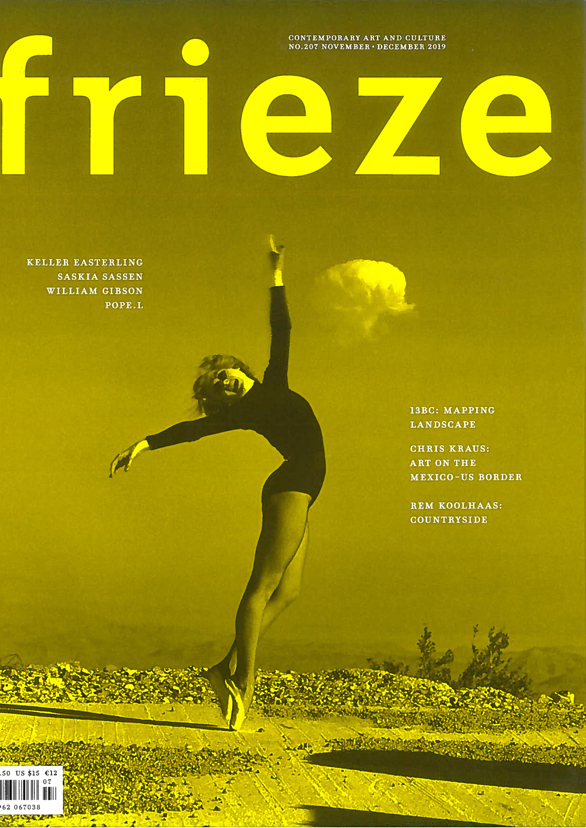
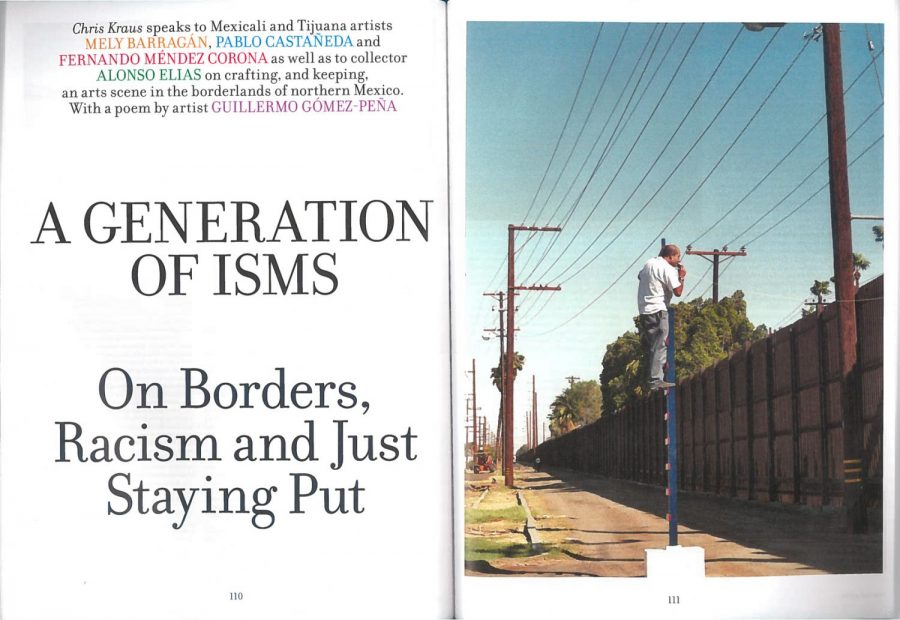
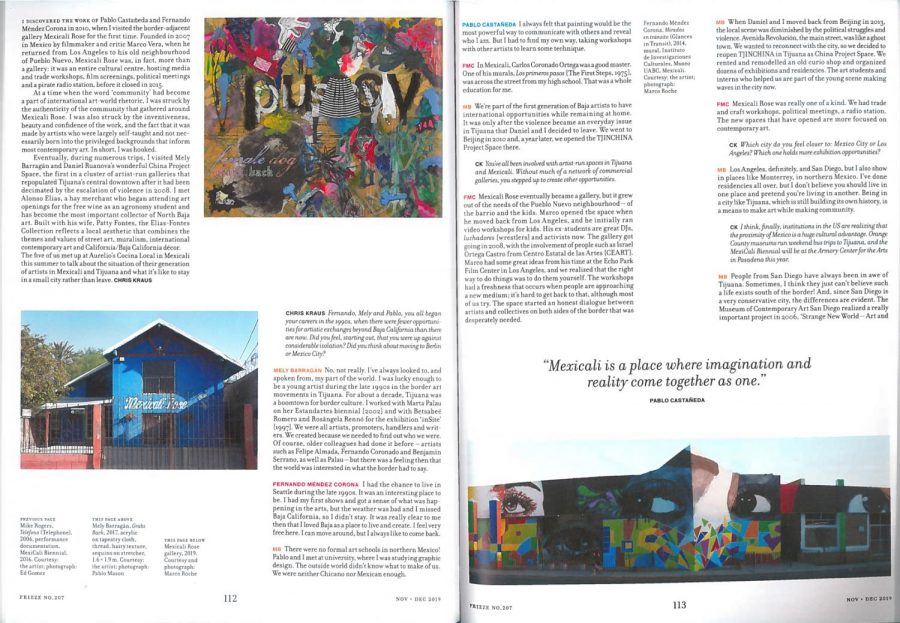
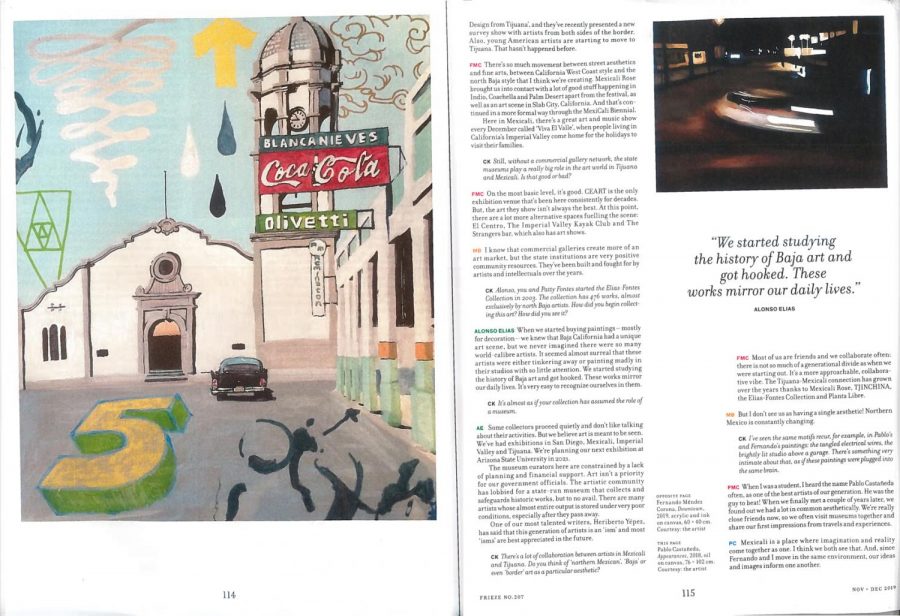
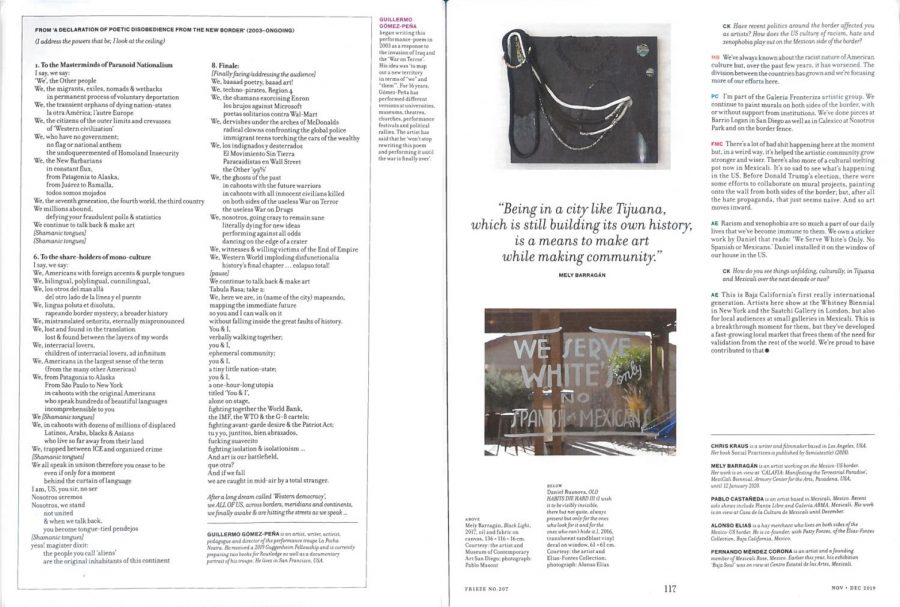
Discussion Closed